Date of Incident: 25 March 2017
Location: Al-Lataminah, Hama
Date of Report: 24 August 2019
Introduction
Whilst investigating the alleged use of an “M4000 Syrian Chemical Bomb” in Lataminah on the 30 March 2017 I was reminded of another alleged chemical incident that was widely reported from the 25 March 2017 at Lataminah hospital. In this event, it was claimed a chlorine cylinder broke through the roof of an underground hospital and landed in the entrance area. Chlorine gas leaked out and swept through the underground building and given the lack of ventilation some 30+ people suffered side effects whilst 3 people lost their lives including a surgeon.
I was drawn to this event for several reasons, the main one being the same reason that has attracted me to the other investigations I have carried out, the evidence not stacking up. I decided to take a closer look and the deeper I looked the odder the evidence became. What was more concerning is that the OPCW-FFM investigated this event, albeit without visiting the site and relying solely on opposition based NGOs to supply the evidence, witnesses and narrative.
Upon reading the FFM report I was gobsmacked at just how poor it was. Imagine being in court charged with murder and the judge leaves it to the prosecution to supply the evidence and the witnesses to give evidence against you. Picture that and you already have a good grasp of the FFM report.
The question I ask in this report is: Does the evidence match up with the charge? That charge being that the SAA delivered chlorine cylinders as weapons to the Al-Lataminah hospital and surrounding area on the 25 March 2017?
For total transparency, this report will include a longer more detailed presentation.
The Narrative
There are various claims of the time the alleged attack on the hospital occurred but the one that appears to be more widely accepted than the others is around 3 pm on the 25 March 2017. It is then alleged a second attack happened 15 minutes later in the surrounding area.
It is claimed that anything between 1 and 9 barrels was dropped that day. Some witnesses claim some of the barrels had contained explosives whilst the others were filled with chlorine.
HRW (Human Rights Watch), which is opposed to the Syrian government, claimed, in a detailed report entitled “Death by Chemicals“;
On March 25, 2017, a helicopter dropped at least one improvised munition filled with chlorine on a makeshift hospital in al-Lataminah, a village in the northern Hama countryside, according to five witnesses whom Human Rights Watch interviewed, and photographs of remnants of munitions.
They go on to quote a Dr.Mahmoud al-Mohammed who was, apparently, manager of the Al-Lataminah hospital in question;
According to Dr. Mahmoud al-Mohammad, the manager of the hospital in al-Lataminah, because previous attacks had twice hit buildings used as hospitals in the village, they had moved the hospital to a building outside the village and reinforced the roof with steel covered by soil.
He continues;
Dr. al-Mohammad, who said he arrived at the hospital shortly after the attack, told Human Rights Watch that the attack happened around 3 p.m. on March 25. A helicopter dropped two barrels, he said. One barrel with explosives fell about fifty meters from the hospital, the other hit the roof of the hospital.
Dr. al-Mohammed’s claim would go on to form some of the evidence noted by the OPCW-FFM, as you will see.
Here the doctor makes mention of a barrel with “explosives” that landed around 50 meters away from the hospital.
Of the casualty figures he says the following:
Dr. al-Mohammad, the hospital manager, said that the attack killed three people due to chlorine exposure…..In total, 32 people suffered medium to critical injuries due to the chlorine exposure Dr. al-Mohammad, the hospital manager, said that the attack killed three people due to chlorine exposure…..
During my investigations into the incident the casualty figures all range in and around the 30-35 number so the above claim of 32 fits with the other claims. The number of 3 dead seems consistent with one or two accounts claiming 4 dead and 2 dead.
Geolocation of Hospital
The FFM geolocated the hospital to the northwestern outskirts of Lataminah city. They describe it as:
…built inside a cave carved within a rock formation.
They provide these images of the location:
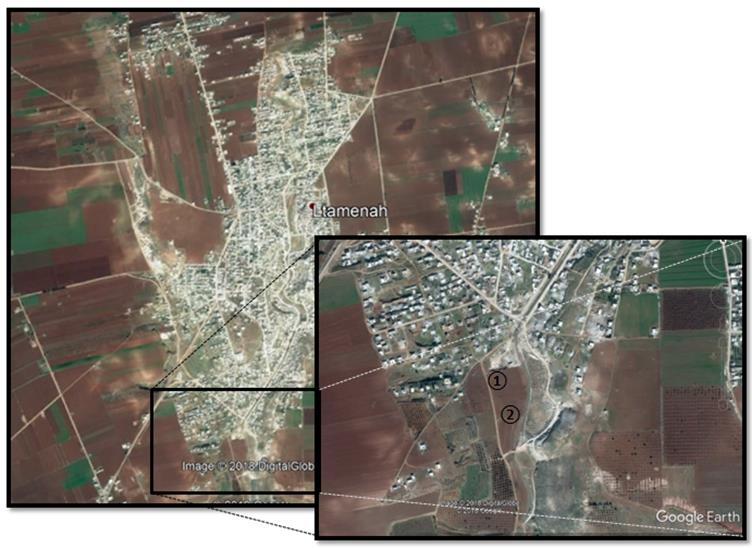
Using Google Earth I geolocated the site to coordinates: 35°19’32.10N 36°36’43.26E
Having reviewed all the available data this would appear to be the correct location.
Here is a better view that I obtained from Google Earth: (click to open in new window) We’ll come back to this image later, for now I wanted to establish its location then as we proceed you will see how it’s easily verified.
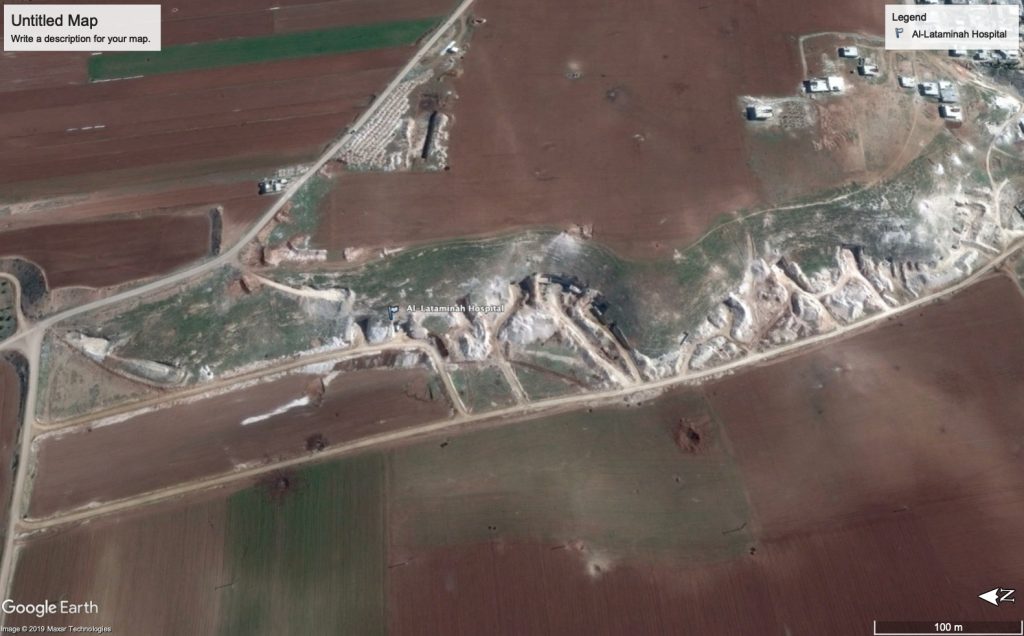
This is a close-up of the entrance to the hospital. The yellow dotted line denotes the approach and the yellow arrow points towards the entrance. The red dot denotes the alleged impact location of the cylinder.
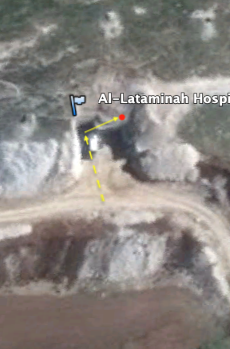
Here is a view from the entrance of the hospital. I have added the yellow line as a guide for you.
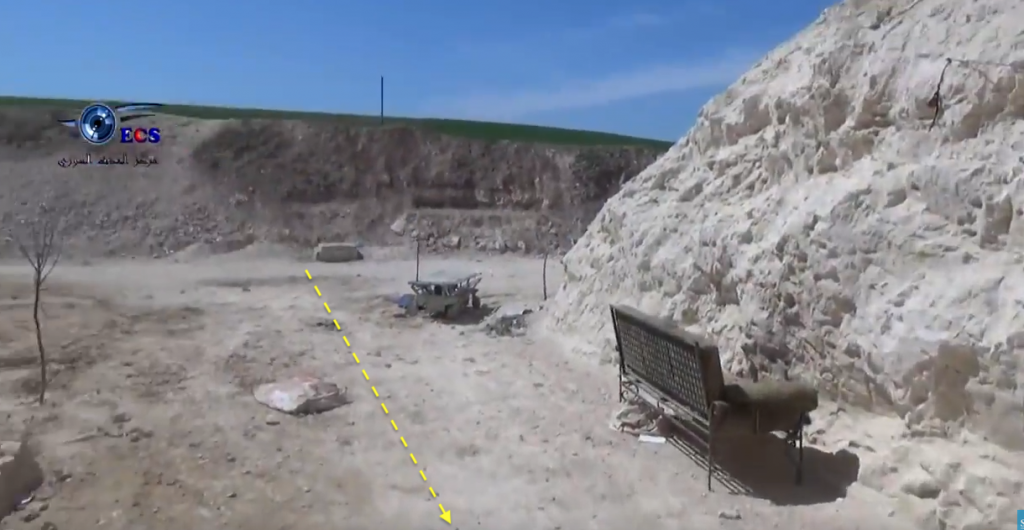
And now we’re at the front door.

With the location and alleged impact site established. Let’s now move on to the evidence.
Al-Lataminah Hospital Cylinder
The earliest footage I have uncovered of the hospital after the alleged impact was uploaded to YouTube on the 26 March 2017 at 19:01 UTC (17:01 GMT) according to its metadata.

Upon the cameraman entering the room we see quite a bit of rubble spread all over the floor right out towards the entrance.
You will note the mound of soil to the right as he walks in and directly above this the alleged impact crater (which he doesn’t show but is there). He quickly scans around the room, briefly showing the cylinder that is supposedly responsible for the crater.
The debris in the room and broken pieces of concrete, coupled with the hole in the roof, would suggest that something happened. The aim of this report is not to try and theorise what did happen in the room. My focus is on the evidence and what it tells us happened or didn’t happen.
I will your draw attention to the distance from the soil mound in the right corner of the room to the resting place of the cylinder. Also, note the turned over hospital bed and general disorder within the room.
Let’s now look at the cylinder and assess it for damage.

Left is an image of the cylinder when it was brought outside. Right is it inside as per the video shot (I’ve brightened it up a little). I have also matched the distinguishing marks for verification.
Let’s take a look at both sides of the crater, from the top and bottom:
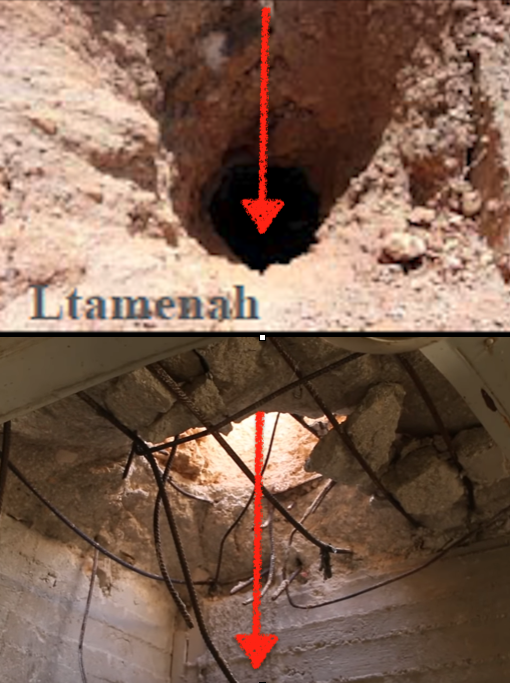
Looking at the outside impact site suggests a vertical impact, therefore, a vertical drop.
So let’s proceed on the assumption the official narrative is correct and therefore the cylinder was dropped from a helicopter, penetrated dense soil, smashed through reinforced concrete, went clean through the rebar, snapping it in two, and then continued to it hit the floor.
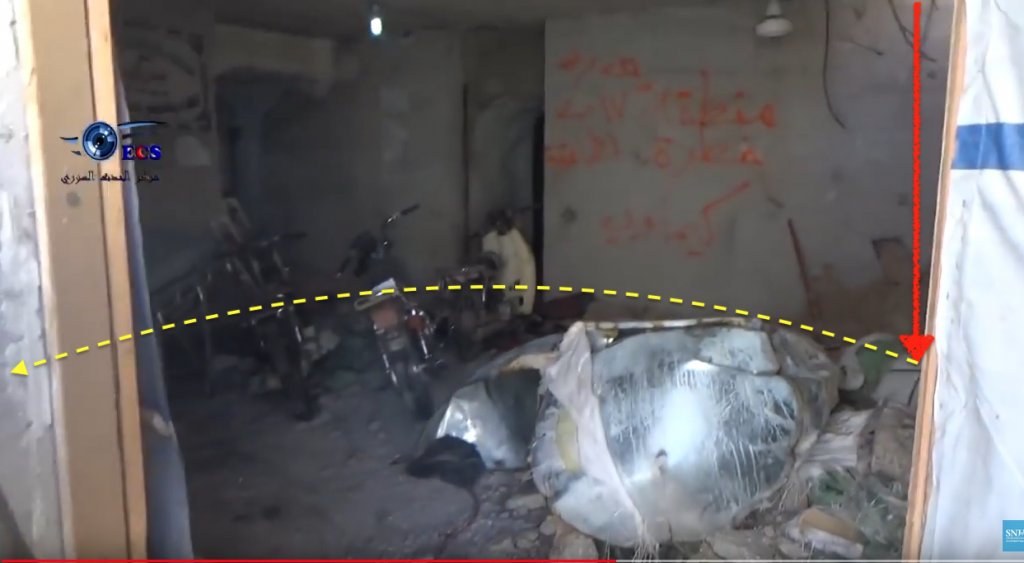
At which stage it still somehow has the velocity to rebound off the floor, laterally across the room, avoiding the material lying next to where it would have landed, therefore an arc trajectory would be required, hits the bed knocking it over then comes to rest at the far side of the room, with one end resting on, what appears to be, a settee/sofa.
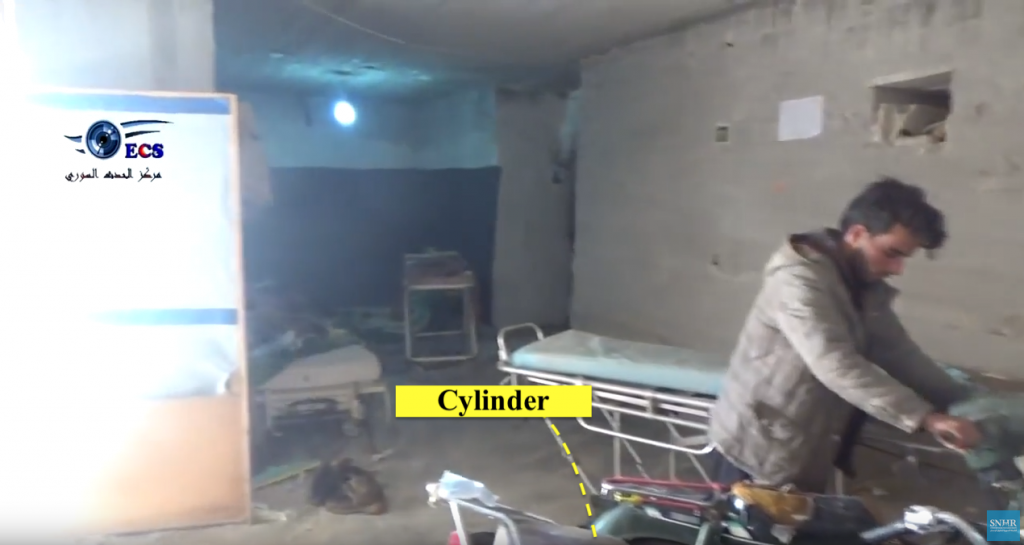
There are so many things wrong with that theory that I can only attempt to address the obvious problematic issues as there’s so much more to cover in this investigation.
Let’s now take a look at the resting position of the cylinder as depicted above in my imagery. I will draw your attention to a shadow of a sofa/settee that the rear end of the cylinder is resting upon in an almost 45° angle.
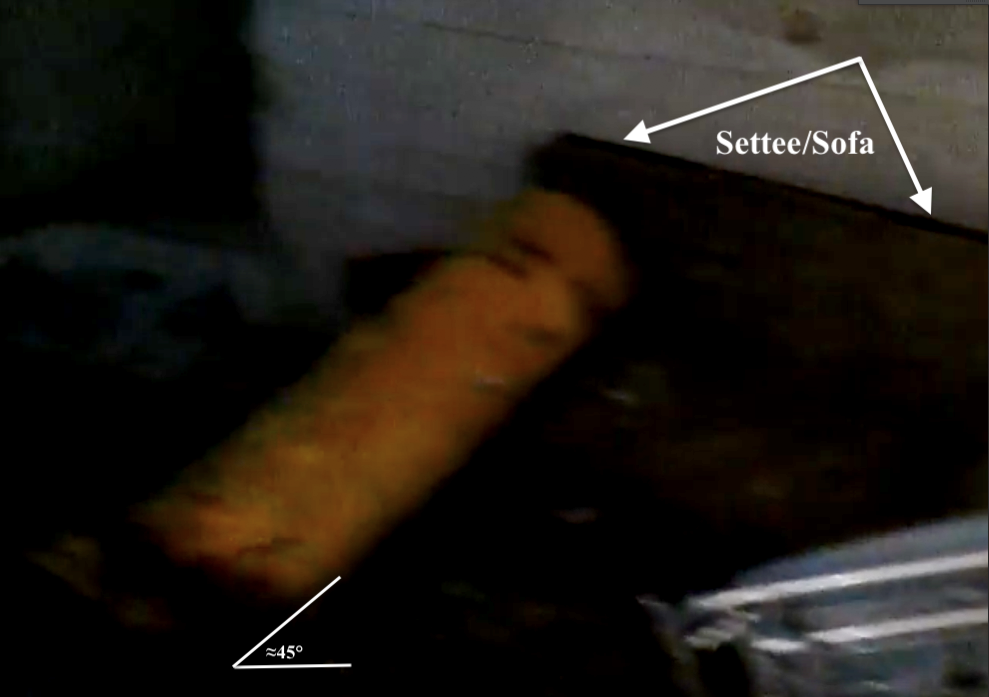
If you need a reminder of the layout of room then watch the short video again.
Here’s where it begins to get interesting. Unlike the “Location 4” cylinder at Douma (the bed cylinder) which was only claimed to have smashed through a concrete ceiling reinforced with rebar, hit the floor and then jumped laterally on to the bed. This cylinder puts that one to shame in its aerobatic abilities.
We know from the image of the cylinder outdoors the part that came into contact with a hard surface was the flattened end with a split in the metal.
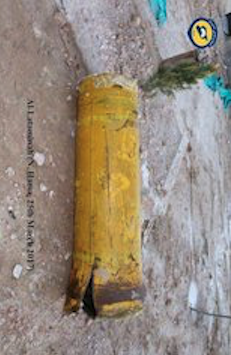
The cylinder would have had to drop in vertical free-fall to hit the soil and leave a perfect vertical footprint that we see at the crater. Therefore it would have fallen in the angle as depicted above. After punching through the dense soil it would then have had to break through reinforced concrete and split the rebar.
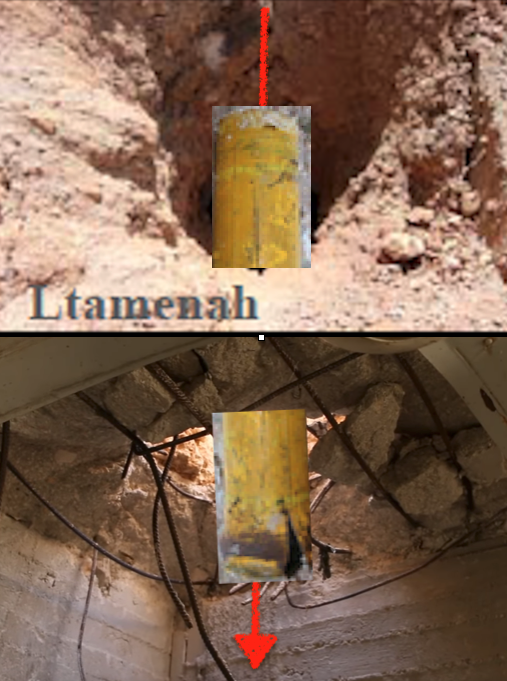
After penetrating through the rebar the cylinder would have hit the ground at the same angle given the angle of the crater.
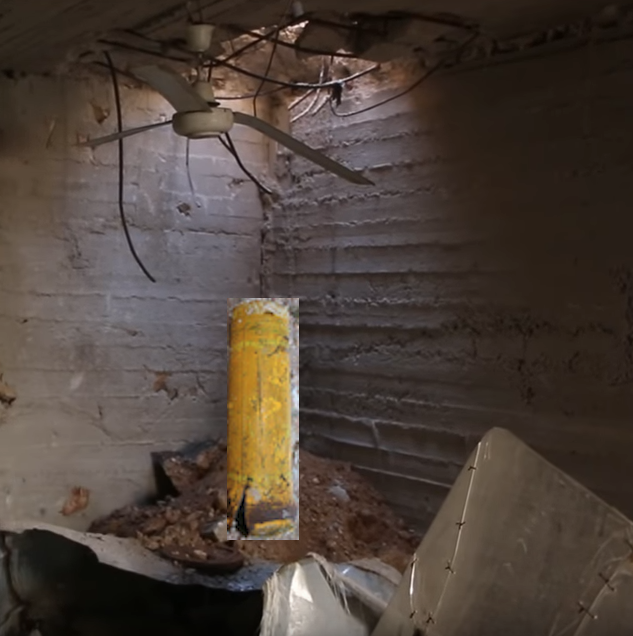
With regards the soil mound, my view is that the debris and soil you see in the image would have followed the cylinder rather than preceding it. Bear in mind that as the cylinder hit the earth the soil had nowhere else to go only laterally as the hole in the concrete wouldn’t have been made yet. Even as it was made by the cylinder there wouldn’t have been enough room or time for it to have gotten through. But! It would have followed the cylinder thus impeding any further movement after it hit the ground. In this study, I ignore that factuality and assume the cylinder hit the floor, unimpeded, and naturally ricocheted off the ground.
To ascertain what direction the cylinder should have gone in, after a vertical impact, is outside of my abilities and not important to this study as I assume the official narrative is correct. Its directional onward movement would depend on the angle of the damage to the cylinder end that impacted the concrete. That would certainly alter its trajectory as it hit the floor.
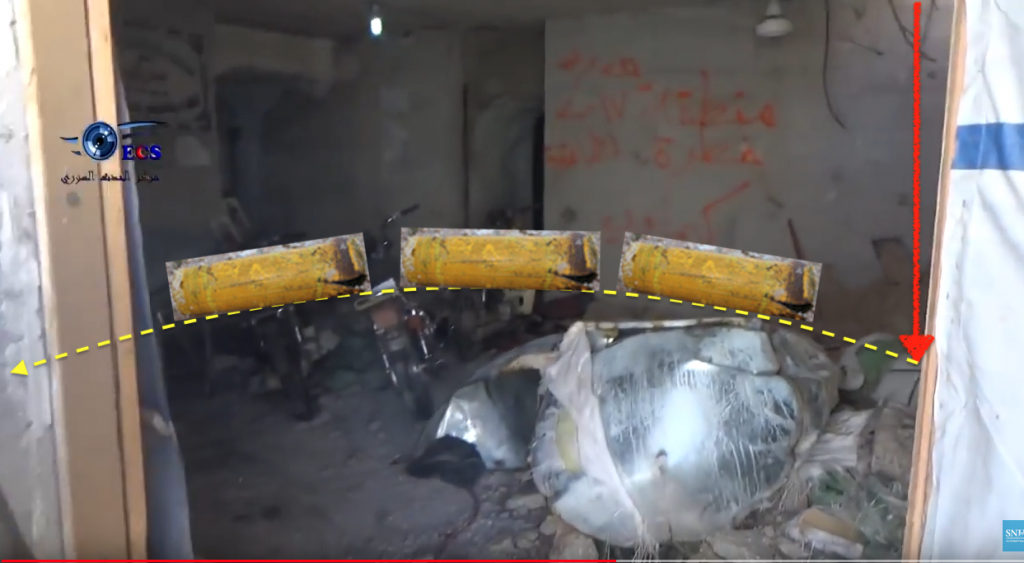
Here I assume the cylinder hits the floor, ricochets with the opposite end leading, in an arc maneuver (remember it has to clear the debris to continue its journey), to it hits the hospital bed and flips again, this time with flattened end leading and then somehow rotates 90° to end up with the flattened end facing the door and the opposite end on the settee. Confusing, isn’t it?
I have run that scenario past a few, rather well-qualified people, in the field of physics, who have advised me that, not alone is it absurd, but “the stuff of conspiracy theorists” – to quote one. Another refused to fathom the idea and instead dismissed my hypothesis outright.
There are simply too many uncontrollable variables in this scenario and a lot of stars need to align to make this happen. But, as already said, I am assuming the official narrative is correct. So let’s proceed in that in mind.
What does the physical evidence tell us? What does the data say?
Here’s how I begin: The cylinder is alleged to have hit soil first, then concrete, then rebar, then a concrete floor. I first ask myself, is there evidence the cylinder penetrated soil? There’s clearly evidence of a crater, but is there evidence the cylinder caused it?
Let’s take a look at the cylinder for any evidence.

But what about the alleged impact end of the cylinder? Is there any evidence of it having punctured the soil after being dropped from a helicopter? Can you see any evidence of soil, or soil-like substance, on that cylinder end? [click on image for larger picture]. You would certainly imagine that there would be quite a bit forced into the grooves or around the nozzle. I can accept that impacting concrete on both the ceiling and floor would disperse loose soil easily enough but for there not to be ANY soil? Does that make sense?
Here are two images in one released by the White Helmets of the flattened cylinder end. See if you can spot soil residue here, bear in mind these are the first photos to be taken after the alleged event took place:
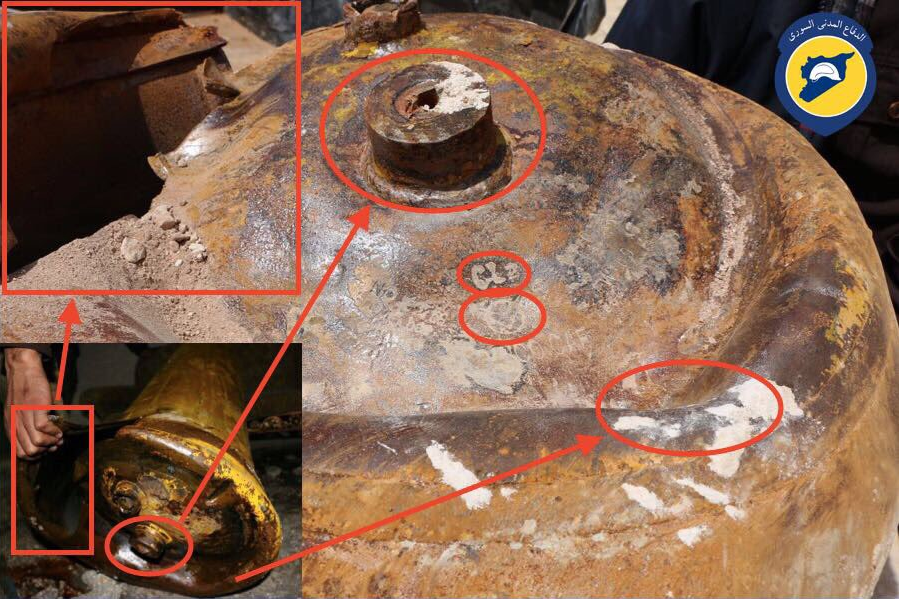
You can see some loose dirt in the top left-hand red box which was not as a result of impact for 2 reasons;
- The prominent image of the cylinder to the right was photographed outside on a dusty road, hence the loose dirt
- The bottom left image is the raw image from the hospital room and has no dirt on it
Even at that, look at the hole in the nozzle. No soil to be found where you’d expect it to be found in this instance.
But let’s assume, for this study, any soil was dispersed after the various impacts on solid surfaces. But what about the rebar? Is it not plausible to suggest there would be markings to the side of the cylinder as it pushed through the metal rebar towards the floor? Let’s briefly recall “Location 2” in Douma and the alleged rooftop cylinder.
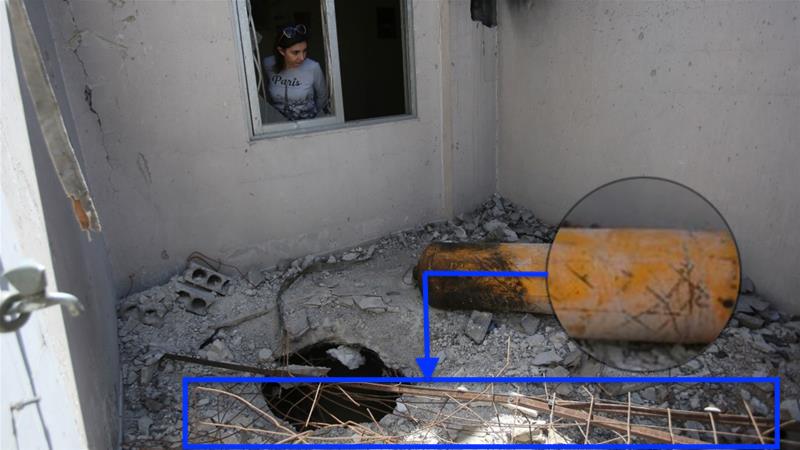
The markings under the magnifying glass are alleged to have been caused by the fine metal grill denoted in blue. This cylinder’s impact, according to the official narrative, was lessened by it hitting the corner of a roof first, yet even then as its velocity had been greatly diminished, fine metal grill left quite distinctive markings on its body.
What about the hospital cylinder in this investigation? Surely there must be some markings of the rebar having scraped its sides as it travelled through?
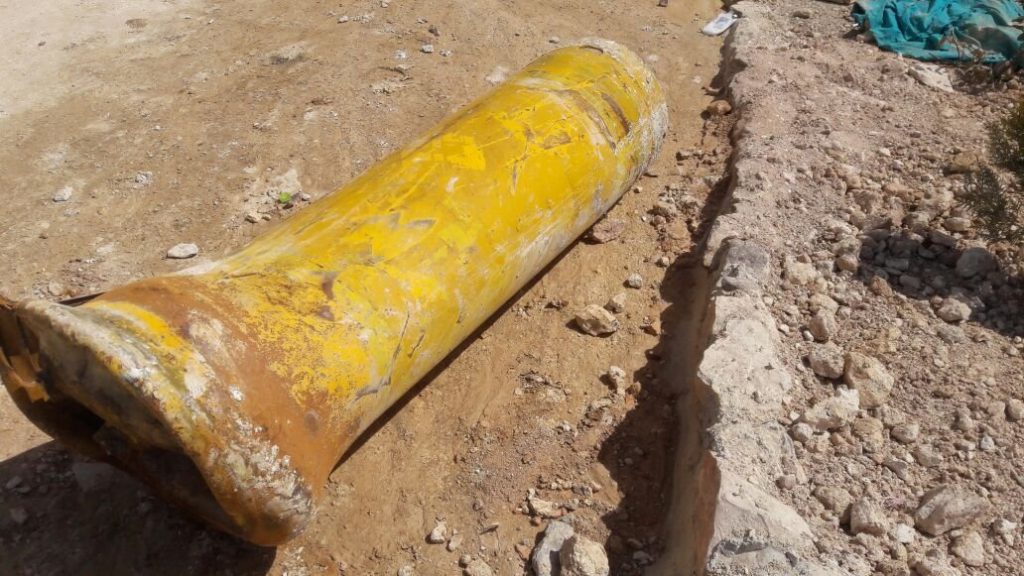
Any evidence on this image?
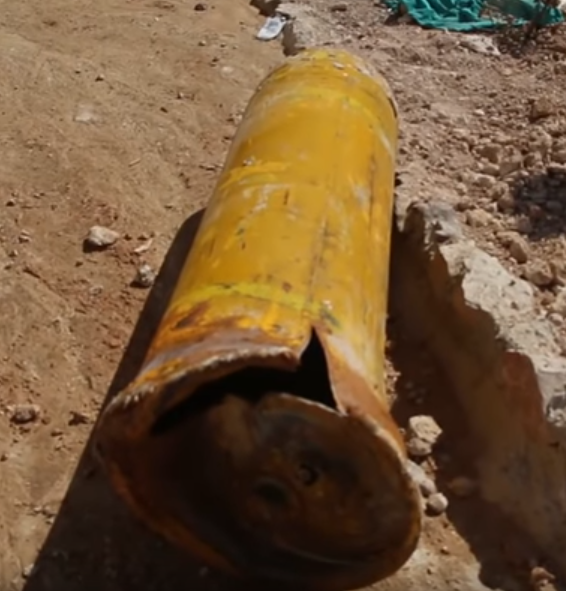
What about here? Any scratching, scoring or marking from rebar? Any soil residue?
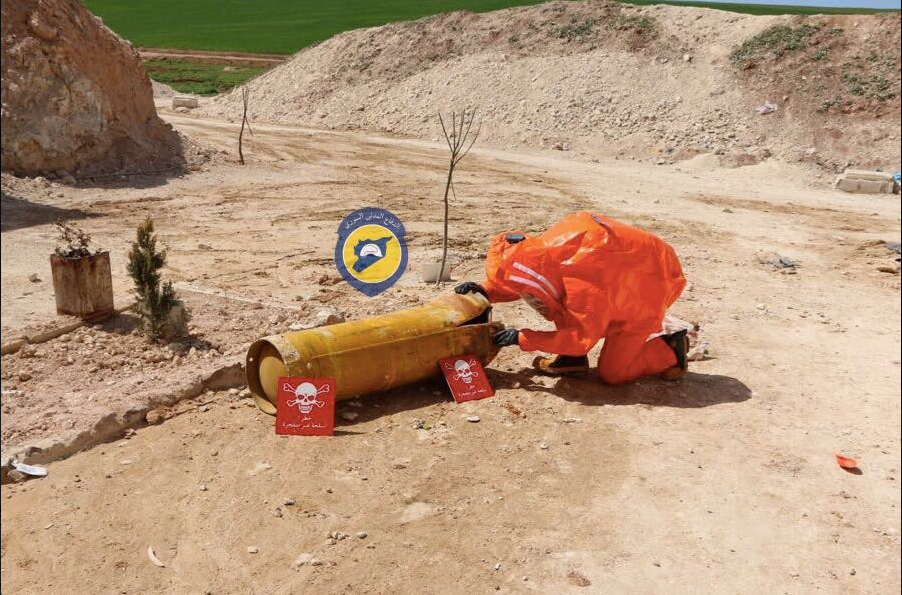
Or how about this one? Any scratching to the sides that you can notice or deep scarring of the paint?
Drawing Comparisons
Is there any evidence of similar cylinders being used in alleged chlorine attacks and also claimed to have been dropped from helicopters, that we can compare with this cylinder? The answer to that is; Yes.
Here is a similar type of cylinder that was allegedly used at Saraqib in Idlib on the 4th of February 2018.
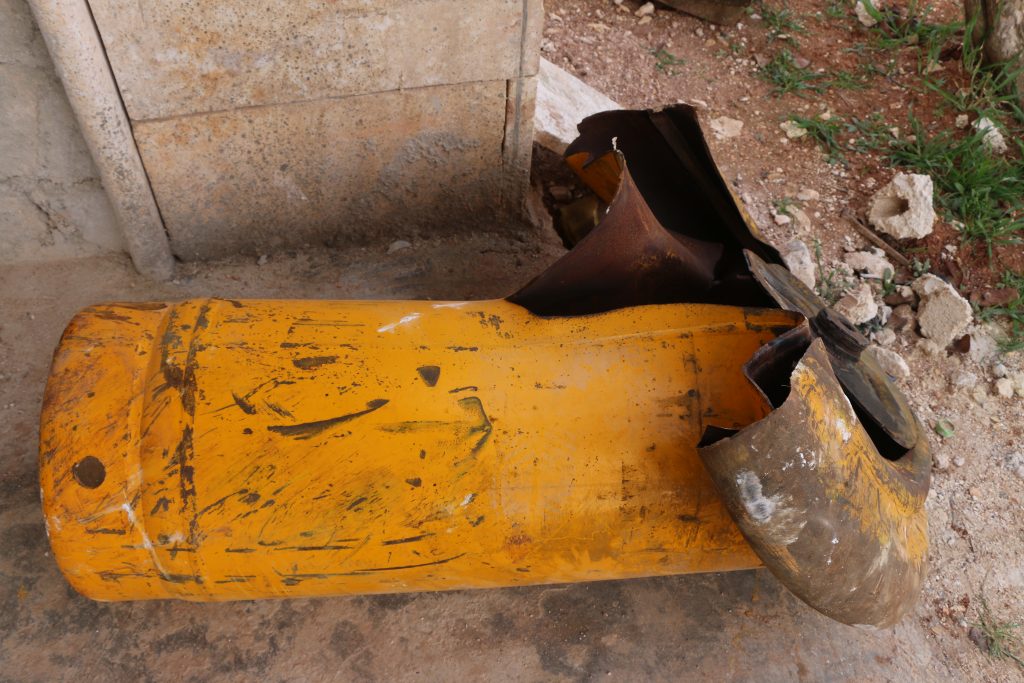
Notice the massive deformation to this cylinder and the significant tearing of its body? It is alleged, like the hospital cylinder being discussed here, that it was dropped from a helicopter only here it allegedly hit a field. Let’s check the alleged impact site;
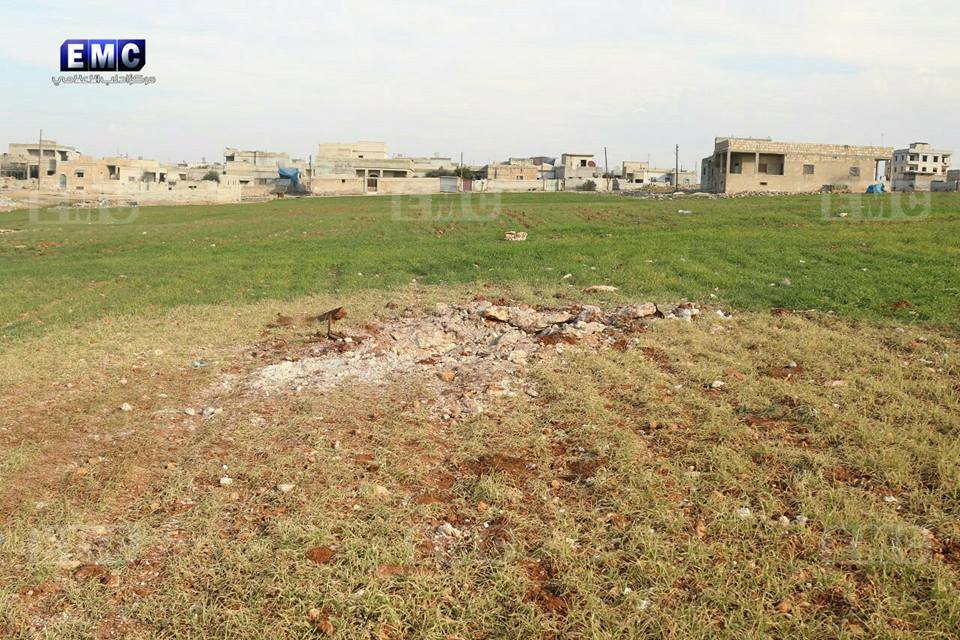
So this cylinder hits the soil, leaving unremarkable impact damage, yet ends up badly deformed. Whilst the hospital cylinder, penetrates dense soil, smashing through reinforced concrete, splits the rebar, hits the floor and bounces across the room knocking over a hospital bed and comes to rest partially upon a settee with little damage.

Incidentally, the OPCW-FFM also investigated the Saraqib incident and also concluded it was genuine.
7.4 The FFM determined that chlorine, released from cylinders through mechanical impact, was likely used as a chemical weapon on 4 February 2018 in the Al Talil neighbourhood of Saraqib.
The FFM can’t have it every way. They can’t ask that we suspend the laws of physics to help them reach a conclusion. They also can’t ask us to accept major rupturing to a cylinder after it left unremarkable damage to soil whilst then asking us to believe the same type of cylinder had a lot less damage after it hit the soil, concrete, rebar, concrete, a bed then a settee.
Impacting End of Cylinders
For anyone who studies alleged chlorine attacks using this type of cylinder, you will be only too aware that for some reason the impacting end is always the top of the cylinder with the filling nozzle. How this occurs defies physics and has never been explained by anyone, to my knowledge.
These cylinders do not have tail fins that would help stabilise their flight after a period in freefall. Whilst a tail fin helps stabilise flight it also helps orientate an end of a projectile downwards. Without stabilisation, the cylinder would continue to spin, picking up speed, until it hit the ground. There is no telling what side or end of a cylinder would impact the ground first. Here is an example of “barrel bombs” being lobbed from a helicopter over Syria. Pay close attention to how, initially, the bombs spin uncontrollably before stabilising. The stabilisation is the result of the tail fins attached to both bombs. Note how the tail fins also help orientate the projectiles with one end pointing towards the earth.
So how is it these cylinders, minus tail fins, always hit the ground on their top end? It cannot be explained according to those I’ve asked. If you can explain it, I’d be interested in hearing.
Furthermore, I have been unable to find any footage showing these cylinders being thrown from helicopters which, given how the opposition “aircraft spotters” always appear to know when an attack is imminent, is a bit odd. (I’d be very grateful if any reader has come across such footage could get in touch with me.)
Recap
It is alleged that a single chlorine cylinder was thrown from a helicopter and hit the roof of the Al-Lataminah hospital in Hama.
This cylinder free-fell in a vertical fashion, without a tailfin to stabilise its flight and thus give preference to an end to be orientated downwards, yet it still managed to hit the earth vertically
Upon hitting the ground it penetrated dense covering soil, used to conceal the existence of the roof, proceeded to smash through a reinforced concrete ceiling, splitting the rebar. It then continued to it reached the floor when it was laterally redirected in an arc pattern across the room, knocking over a hospital bed, then flipping itself around and landing at a 45° angle with one end of the cylinder on the floor and the other end on a settee.
Due to the impact on several solid surfaces, the flattened cylinder end split open releasing chlorine into the room and given the lack of ventilation in this underground building the gas proceeded to spread causing casualties and fatalities.
The OPCW-FFM Report
Citing “a witness” the FFM notes:
At approximately 15:00 hours on 25 March 2017, a witness reported two raids carried out by helicopters in the northwestern outskirts of the city of Ltamenah. During the first raid, two barrels were dropped. Two additional barrels were dropped during the
second raid, 15 minutes later.
They continue:
A different witness stated seeing a helicopter dropping
the first two barrels. The sounds following the impacts were described as weaker detonations compared to explosive barrels.
So, from these witness statements, we can deduce that there were either one or two attacks. The first one at 15:00 dropped two cylinders followed by a second attack 15 minutes later, again, with two cylinders.
The FFM proceeds on the basis that 4 cylinders were dropped in 2 separate helicopter raids. Their standards of evidence would appear, in this instance, to be seriously lacking. Allow me to validate that claim.
Section 5.59 of the FFM report reads;
The impact location of the hospital as indicated by witnesses are shown in Figure 13. The first cylinder (1) pierced the rooftop of the ER at the entrance of Ltamenah Hospital. The second cylinder, third cylinder, and fourth cylinder fell to the ground at the respective distances of approximately 50 meters northwest to the hospital, 200 meters east to the hospital, and 100 meters to 150 meters south to the hospital. Witnesses reported that vegetation appeared burnt for about 100 metres from the impact points.
I draw attention to the exact wording of the FFM report. They don’t say these locations are alleged instead they say, with a degree of certainty, “The first cylinder pierced..”, “The second…third….fourth…fell to the ground..” What is the evidence given to us from the FFM to support these claims? This tiny image:

There’s your evidence that 4 cylinders were dropped from helicopters on the day in question.
Section 1.2 of the FFM report reads:
..the team assessed the credibility of the allegations based on information collected from open sources
Did they? The date of their report was 13 June 2018. Join with me as I review the “open source” material between the date of the alleged incident and the date of their report.
The Open Sources
Oddly, the three images offered by the OPCW (above) depicting craters of three of the four alleged chlorine cylinders are not found in any of the open sources I have come across. Likewise, the open-source evidence I have come across is not mentioned in the FFM report. You will note, however, the very low resolution and size of the images provided by the mechanism and also the lack of actual cylinders in said images.
Moving on with the “open sources”;
Abd al-Munaf Faraj al-Saleh, the head of Syria Civil Defense in al-Lataminah…shared a photo of a deformed yellow gas cylinder that he said was the one that had hit the hospital roof.
HRW Report – 01 May 2017

Clearly, this isn’t the cylinder that was found at the hospital. Therefore this is verifiable proof, via open-sources, that the head of the White Helmets in Lataminah provided fake information on an alleged attack. Are we to believe that the OPCW missed a HRW report into the very incident they were investigating? And where did the White Helmets get that cylinder they wished to pass off as proof of a chlorine attack? Was this the first time this group has made false claims of chlorine munitions? These are all genuine questions not asked by the OPCW-FFM. Why?
None of this stopped the BBC using this fake image for their headline article on the FFM’s conclusion though;
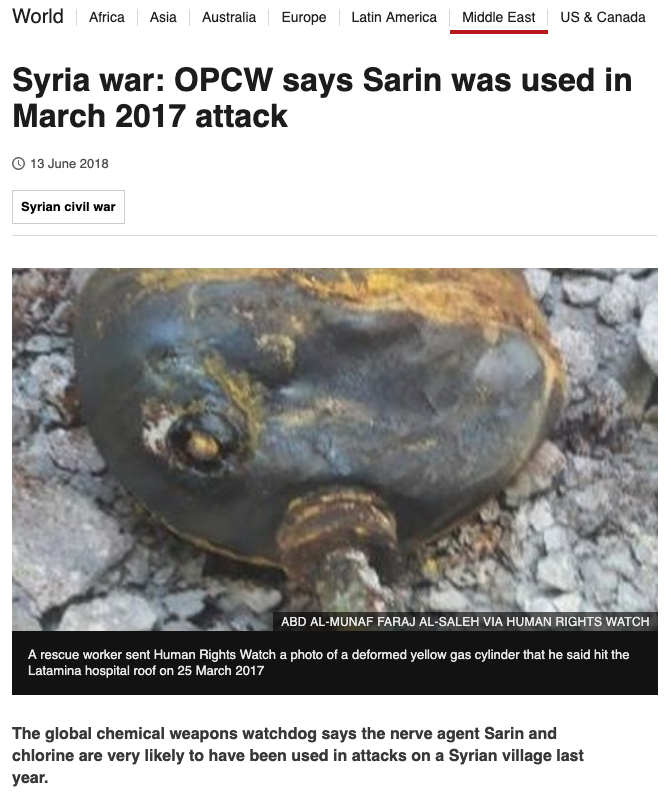
Or what about this cylinder in a video from the “Syrian Network for Human Rights”? It was uploaded on the 2 April 2017 and is alleged to be one of the cylinders dropped on Lataminah that day.
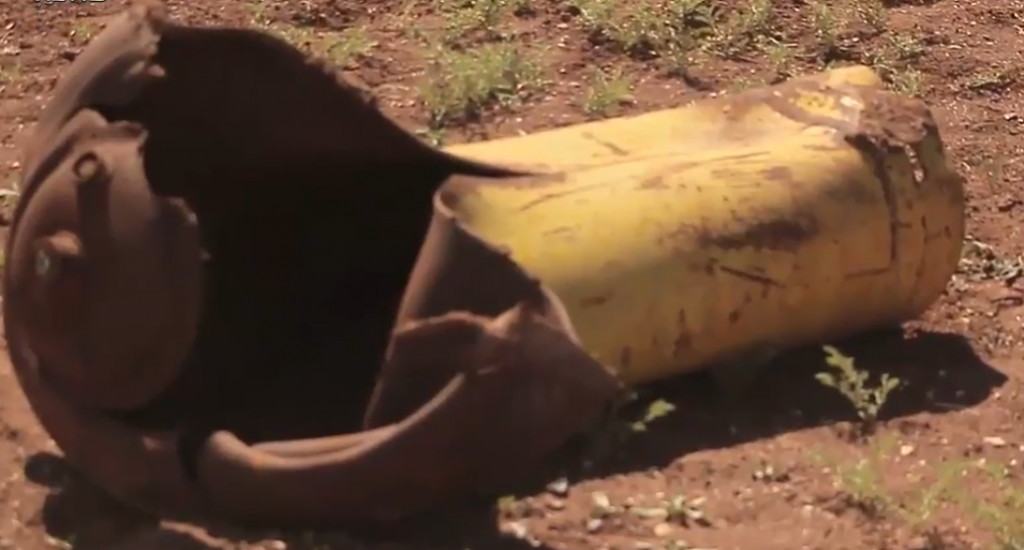
Or how about this one, allegedly dropped on a vehicle and whilst incinerating said vehicle it managed to avoid any scorch marks itself.

This image is from a video from the Thiaq Agency, a pro-opposition news agency that works with the White Helmets. The video can be viewed here. – 26 March 2017
Maybe the FFM might have stumbled across this alleged cylinder from “open sources”? – 2 April 2017
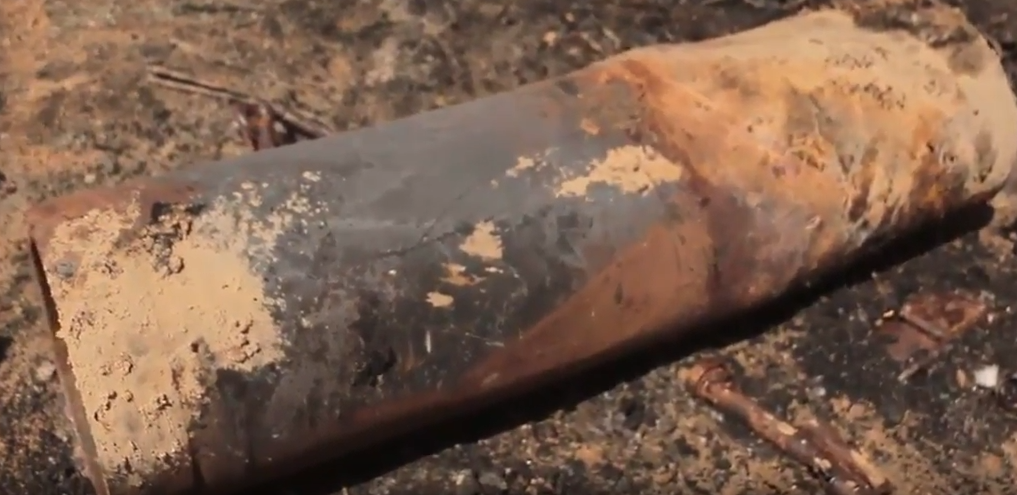
This video was again from the “Syrian Network for Human Rights”.
Are you seeing the pattern emerging? I have provided “open-source” material of alleged chlorine cylinders deployed in Lataminah on the 25 March 2017 from reputable opposition sources. Whilst, these videos were all widely circulated on social media long before the 13 June 2018 when the FFM concluded their report, they still failed to mention them. So either,
- They ignored the reports
- They deemed the reports false
- They didn’t see them
I argue that any of these scenarios should concern the reader greatly for obvious reasons. If they didn’t see them then I question their competence and desire to look for evidence. If they did see them and deemed them false then the reference should have been made with regards the same in their final report of evidence obtained, considered and rejected. That didn’t happen. At best in this instant, the opposition is again proven to be staging evidence as I have categorically proven throughout this blog they do. If, however, the FFM found these reports and decided to ignore them then I again question their motives, integrity, and competence. Why should vital evidence be ignored and on whose order?
There are other examples but I believe the point has been made.
The OPCW-FFM’s Sources
5.61 The FFM received environmental samples and metal objects on 10 and 12 April 2017 and 19 February 2018.
The alleged incident occurred on the 25 March 2017 and the FFM accepted “environmental samples and metal objects” up to 19 February 2018 – almost a year later!
The next section is not a joke. This is word-for-word from the FFM report:
5.62 At the time of handover, the team was informed that all samples were taken by the parties who maintained their custody. A member of the SCD who took the samples was present at the handover and provided information on every sample. This information was supported by interviewing the same SCD member and by photographs and videos handed over during interview. The information was corroborated by interviewing two additional SCD members
“At the time of handover, the team was informed that all samples were taken by the parties who maintained their custody.” – That’s the level of evidence the FFM required in this investigation. As long as someone told them so then it must be true. I find this alarming.
“A member of the SCD (White Helmets) who took the samples was present at the handover…” – Well that seals the deal then. A belligerent in the conflict has told you the evidence is genuine so who are the FFM to argue with that?
“This information was supported by interviewing the same SCD member…….The information was corroborated by interviewing two additional SCD (White Helmet) members.
Before I get charged with being against the White Helmets for the above statements…
Let’s say the Russians had set up a rescue group called the Yellow Helmets in Syria [it’s strongly suggested the British set up the White Helmets via a gentleman called James Le Mesurier]. Now consider this statement from the FFM:
5.62 At the time of handover, the team was informed that all samples were taken by the parties who maintained their custody. A member of the Yellow Helmets who took the samples was present at the handover and provided information on every sample. This information was supported by interviewing the same Yellow Helmet member and by photographs and videos handed over during interview. The information was corroborated by interviewing two additional Yellow Helmet members
How does that read? If I came across that statement I would be advising extreme caution and a high degree of scepticism in the claim and questioning the impartiality of the FFM.
4.7 The FFM team identified relevant witnesses through face-to-face interviews or teleconference calls, open-source research, medical records provided to the team, and through interaction with NGOs. Access to witnesses was coordinated with NGOs.
Which NGOs you may ask? The OPCW answers by saying:
In addition to liaising with representatives of several NGOs, including but not limited to the Same Justice Chemical Violations Documentation Centre in Syria (CVDCS) and the Syrian Civil Defence (SCD), also known as White Helmets
Given the CVDCS is not on the ground amongst the various opposition groups in the manner the White Helmets are it is safe to assume that, like Khan Sheikhoun, the FFM relied upon this group, a belligerent in the Syrian war, to supply them, witnesses.
4.8 Furthermore, the FFM coordinated with the NGOs to organise the movement of the witnesses.
Very revealing. So the FFM relied upon the White Helmets to find and bring them evidence of the alleged events, to provide them witnesses and to bring these witnesses to them.
FFM Conclusion
6.9 The FFM determined that chlorine was released from cylinders through mechanical impact. The FFM concluded that chlorine was very likely used as a chemical weapon at Ltamenah hospital and the surrounding area on 25 March 2017.
Recap 2
The chlorine cylinder shows no signs of having impacted soil or any signs it proceeded to split the rebar in a concrete ceiling. I compared the markings on a cylinder from Douma that was alleged to have hit some fine wire mesh which resulted in impact markings. Yet the hospital cylinder broke through strong steel rebar and escaped any markings.
I noted the minimal damage to the flattened end of the cylinder given what is alleged to have happened to it when compared to the cylinder allegedly used in Saraqib in 2018 that was practically destroyed upon hitting a field and leaving an unremarkable impact site.
I noted how a free-falling object unless stabilised, will fall uncontrollably to the ground with randomness to what part of the object hits the ground first. I noted how most, if not all, alleged instances of these cylinders being thrown from helicopters, unguided, always end up hitting the earth top first. This isn’t a realistic prospect and defies the laws of probability.
If an event can have a number of different and distinct possible outcomes, A, B, C, and so on, then the probability that either A or B will occur is equal to the sum of the individual probabilities of A and B, and the sum of the probabilities of all the possible outcomes (A, B, C, and so on) is 1 (that is, 100%).
Source
This quote explains excellently the point I am making. If a free-falling object has three faces [the cylinder in this case] A, B, C – let’s assume A for the top, B for the bottom, C for the sides – then the laws of probability that different cylinders, all the same, would all hit the earth on the same face each time is not possible. Unless you’re in Syria.
I also evidence how the FFM managed their investigation into the Lataminah incident. They relied upon a belligerent in the Syrian war to provide them with evidence and witnesses. I also drew attention to the fact that right up to February 2018, almost a year after the alleged incident, the FFM continued to accept evidence from the White Helmets.
Conclusions
It is my conclusion, based upon the evidence, the chlorine cylinder in question could not have caused the damage it is alleged to have caused at the hospital.
Even if we accept the free-falling object did hit the earth top first, the cylinder couldn’t have fallen in a complete vertical path thus allowing it to build up velocity as it reached the earth before impact. Instead, this cylinder would have fallen uncontrollably, therefore, when it hit the ground it wouldn’t have had the dedicated force to a single part to drive through the soil and reinforced concrete leaving a perfect vertical footprint.
Imagine striking something with a hammer. Is more power gained by a straight, direct blow or by waving the hammer about en route to the target?
But if one decides that theory is plausible then the lack of soil and rebar markings on the cylinder must be explained. I argue the lack of the aforementioned is due to the cylinder not having caused that crater. I believe that’s what the evidence points to.
My working hypothesis was the official narrative is true and the onus is squarely on me to prove otherwise. I, therefore, presumed the following at this stage:
- The cylinder hit the earth, top first, after a free-fall
- The cylinder punched through dense soil
- The cylinder continued with great velocity to smash through a reinforced concrete ceiling with rebar
- The cylinder broke through the rebar and continued to it hit the floor.
The official narrative hits another snag here. Depending on the damage indentation to the impact end of the cylinder it could hit the ground and bounce in any direction. It so happened it bounced into the room. But with materials on the floor in its way the cylinder then required enough momentum to leap over the material, knock over a bed and land at the other side of the room.
Given the lack of damage to the bottom end of the cylinder, I can only conclude that it was not involved in any of the major impacts.
It is my opinion, based upon the lack of damage to the cylinder that this could not have occurred.
I believe I have presented evidence the cylinder in the hospital was staged and was not dropped from a helicopter on that day, at that location.
I further believe the FFM’s investigation was carried out in a fashion not becoming of any serious investigative group and was heavily compromised by relying upon the prosecution to present the evidence and the witnesses.
Given that the OPCW-FFM concluded that chlorine was used as a weapon on this hospital and that it was delivered by a “mechanical impact” of a cylinder then this report concludes that the opposition has access to chlorine and staged managed this event with the direct assistance and oversight from the White Helmets. I believe the evidence proves overwhelmingly the lead this group took in this incident in creating the narrative and providing the evidence and witnesses.
I conclude the OPCW-FFM were willing dupes in this investigation.
As always if anyone notices any inaccuracies in my report please feel free to point these out to me here or on Twitter. All constructive criticisms are welcome. – Philip
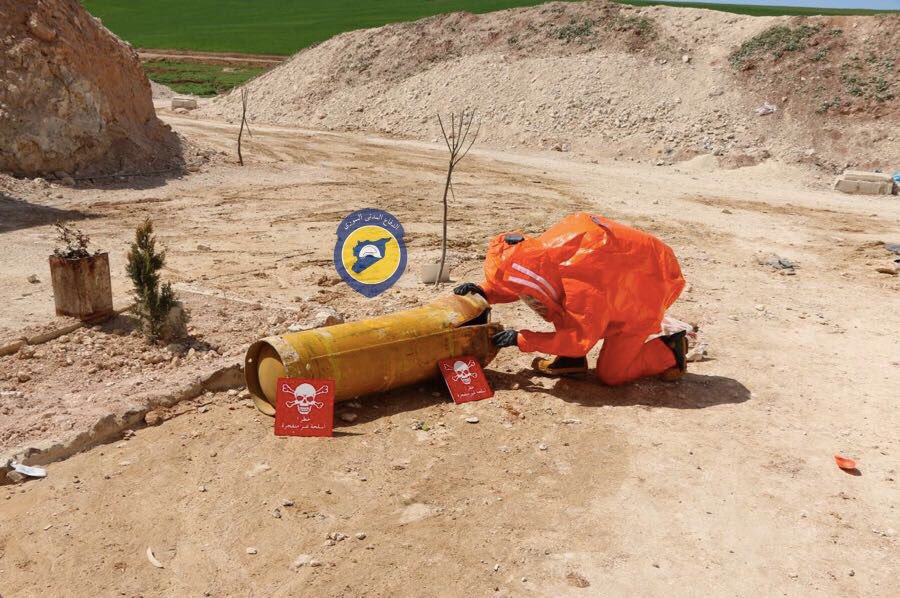
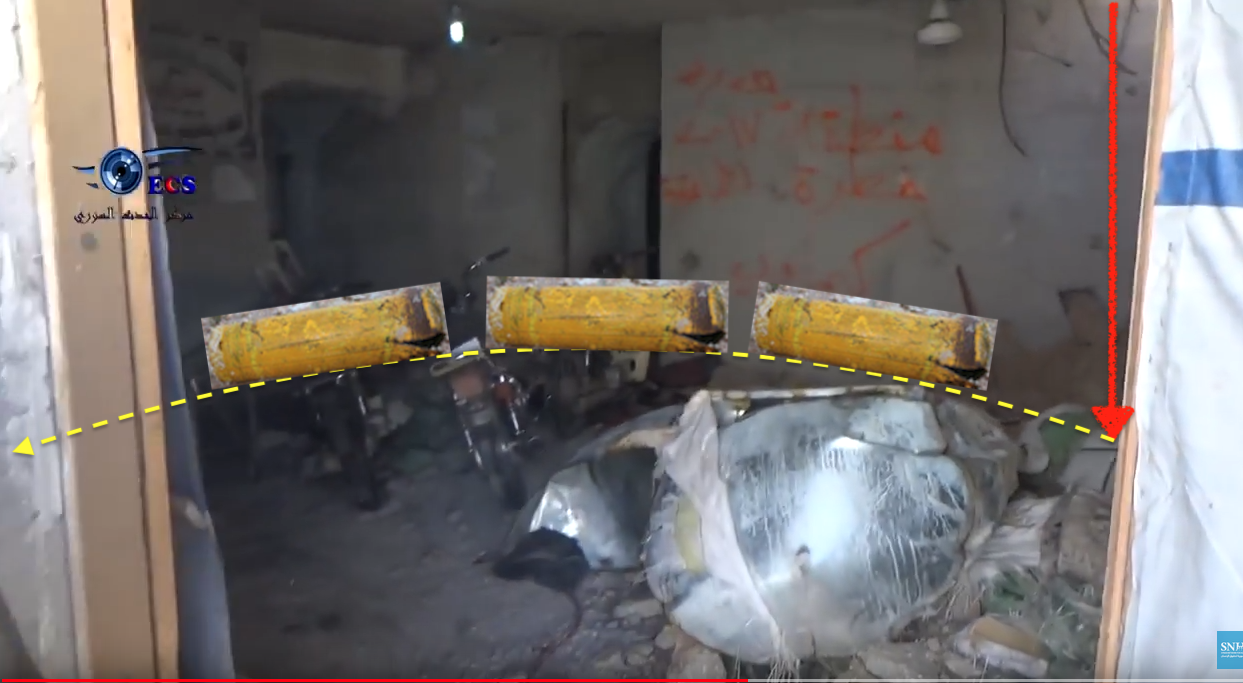
5 thoughts on “OPCW-FFM: Willing Dupes at Lataminah 25/03/17”